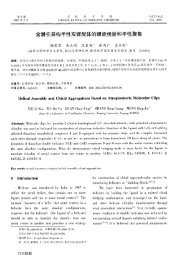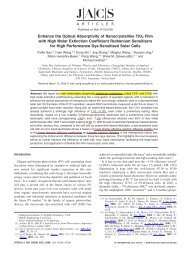Novel hydrodesulfurization nano-catalysts derived from Co3O4 ...
Novel hydrodesulfurization nano-catalysts derived from Co3O4 ...
Novel hydrodesulfurization nano-catalysts derived from Co3O4 ...
Create successful ePaper yourself
Turn your PDF publications into a flip-book with our unique Google optimized e-Paper software.
512 X. Wang et al. / Catalysis Today 175 (2011) 509–514<br />
COS Conversion /%<br />
180<br />
160<br />
140<br />
120<br />
100<br />
80<br />
60<br />
40<br />
20<br />
0<br />
240<br />
260<br />
280<br />
Sulfided NRs<br />
Sulfided NRs<br />
Sulfided NPs<br />
Sulfided NPs<br />
300 320 340 360<br />
Temperature / ºC<br />
Fig. 4. Effects of presulfidation temperature on COS conversion (solid mark) and<br />
H 2S selectivity (hollow mark) over sulfided Co 3O 4 <strong>nano</strong>rods (line) and <strong>nano</strong>polyhedra<br />
(dot). (Reaction conditions: 200 ◦ C, COS 0.1%, H 2 10%, balanced with N 2,<br />
GHSV = 8000 h −1 ).<br />
that in the range of sulfidation temperature, both the COS conversion<br />
and the H 2 S selectivity for the <strong>nano</strong>rods are greatly superior<br />
to that for the <strong>nano</strong>polyhedra, in accordance with the above penetration<br />
time at different temperature. Undoubtedly, the sulfidation<br />
temperature at 300 ◦ C for the <strong>nano</strong>rods is optimal with the longest<br />
penetration time (120 min) and the highest COS conversion (90%).<br />
Whereas for the <strong>nano</strong>polyhedra under the same conditions, the COS<br />
conversions are always kept below 20% accompanied by the negligible<br />
H 2 S formation, which reflects that the performance of catalyst<br />
might depend strongly on their morphologies [21,22]. Compared<br />
to the previous reports, i.e. HDS temperature for COS is usually in<br />
the range of 300–400 ◦ C on Co(Ni)-Mo based <strong>catalysts</strong> [13,14,27],<br />
the fact that the as-prepared catalyst with <strong>nano</strong>rod morphology<br />
exhibiting such high HDS activity at low temperature (200 ◦ C)<br />
encourages us to investigate it deeply.<br />
In addition, it is noted that the H 2 S selectivity over the <strong>nano</strong>rods<br />
surpasses 100%, especially at high temperature, which might be<br />
<strong>derived</strong> <strong>from</strong> the sulfur losing <strong>from</strong> the sulfided catalyst, on account<br />
of the insufficient sulfur species in gaseous phase and the sulfur<br />
disequilibrium between the sulfided catalyst and gas phase [26].<br />
However, this phenomenon emerges just at initial reaction stage, it<br />
would be disappeared when the reaction system stabilizes. Furthermore,<br />
we notice that the extent of sulfur losing is obviously related<br />
to the presulfidation temperature (Fig. 4), i.e. the sulfidation degree.<br />
For instance, 300 ◦ C is the optimal presulfidation temperature for<br />
380<br />
400<br />
180<br />
160<br />
140<br />
120<br />
100<br />
80<br />
60<br />
40<br />
20<br />
0<br />
H 2<br />
S Selectivity /%<br />
the <strong>nano</strong>rods (Fig. 3). Thus, the lengthening of the penetration time<br />
means the deep degree of sulfidation for the catalyst, and could<br />
bring the catalyst on the excellent reactive performance.<br />
3.3.2. Catalytic hydrogenation of COS<br />
The HDS activity of COS for sulfided Co 3 O 4 <strong>nano</strong>crystals was<br />
performed at specific reaction conditions after being presulfided at<br />
300 ◦ C for 3 h. Fig. 5(A) shows the effect of reaction temperature on<br />
the catalytic properties of different-shape <strong>nano</strong>crystals. It is clear<br />
that the <strong>nano</strong>rods are more active than the <strong>nano</strong>polyhedra within<br />
the temperature range employed. The start-up reaction takes place<br />
at about 150 ◦ C in the case of <strong>nano</strong>rods, while for <strong>nano</strong>polyhedra the<br />
temperature above 190 ◦ C. With increasing reaction temperature<br />
<strong>from</strong> 150 to 280 ◦ C, the conversions of COS over two <strong>catalysts</strong> are all<br />
along increased, but the activity gap between them become widening,<br />
the <strong>nano</strong>rods display a surprisingly wonderful performance<br />
at low temperature zone (
















